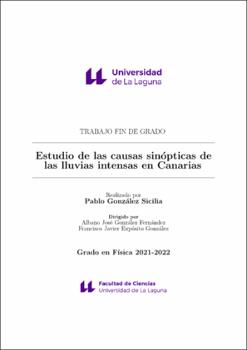Estudio de las causas sinópticas de las lluvias intensas en Canarias.
Author
González Sicilia, PabloDate
2022Abstract
The climate in the Canary Islands is characterized by quasi permanent stability
due to the air stratification over the archipelago. This configuration of layers is composed of a low and moist layer of air that flows over an isothermal surface, mainly
because of the presence of the Canary Islands current and the trade winds from NE, a
layer of thermal inversion that oscillates yearly between 700 m and 1500 m, and finally
a dry layer of air with a NW winds circulation almost all year. Due to this, the climate
perturbations in the islands are induced by the alteration of this layer configuration
and therefore, these constitute the main generators of intense rainfall in the islands.
In this work, we study the synoptic configurations that produce “heavy rain” in
the archipelago to classify the main causes of them, and their spatial and temporal
distribution in the islands. To do this, we made a selection of dates of “heavy rain”
and then, study manually the synoptic patterns that cause them, splitting the synoptic
situations into three main types, Lows, Troughs, and Cutoff Lows, to create a temporal
series of the precipitation data.
Then, to study the spatial distribution of the rain, we separate the times series
of precipitation associated with each one of the synoptic patterns by:
Separation by sectors in the surroundings of the archipelago.
Creation of rain zones by clustering algorithms.
Pressure, geopotential height, and temperature mean anomalies, were calculated
for each one of the sectors to identify the mean synoptic patterns. With this, various
statistical parameters were obtained for the precipitation data, based on the sectors
and rain zones, and so to study the spatial distribution of rain among the islands.
The results obtained for this work show that the method developed for the study
is capable of identifying the main generators of “heavy rains” and their temporal and
spatial distribution, but it cannot be used to make predictions about the mean values
of rainfall.
In general, during the studied period, the rainfall pattern occurs throughout the
winter months with no heavy rainfall events for the months from April to September.
In addition, the synoptic situations with the highest number of associated dates are
the Troughs, followed by the Lows, and the Cutoff Lows. Finally, the spatial distribution of “heavy rains” is highly conditioned by the orography, with the western islands
registering the highest rainfall intensity values. El clima de Canarias se caracteriza por una gran estabilidad debido a la estratificaci´on del aire sobre el archipi´elago. Esta configuraci´on de capas est´a compuesta por
una capa baja y h´umeda de aire que discurre sobre una superficie isot´ermica, principalmente por la presencia de la corriente de Canarias y los vientos alisios del NE, una
capa de inversi´on t´ermica que oscila anualmente entre 700 m y 1500 m, y finalmente
una capa de aire seco con una circulaci´on de vientos del NW casi todo el a˜no. Debido
a esto, las perturbaciones clim´aticas en las islas son inducidas por la alteraci´on de esta
configuraci´on y por tanto, estas constituyen las principales generadoras de precipitaci´on
intensa en las islas.
En este trabajo, se estudian las configuraciones sin´opticas que producen “lluvias
intensas” en el archipi´elago y as´ı clasificar las principales causas de estas en las islas,
as´ı como su distribuci´on espacial y temporal. Con este prop´osito, se llev´o a cabo una
selecci´on de fechas de “lluvias intensas” y luego se estudi´o manualmente los patrones
sin´opticos que las causan, dividiendo las situaciones en tres tipos principales, Borrascas,
Vaguadas y DANAs, para crear una serie temporal de los datos de precipitaci´on.
Luego, para estudiar la distribuci´on espacial de la lluvia, se separaron las series
temporales de precipitaci´on asociadas a cada uno de los patrones sin´opticos mediante:
Separaci´on por sectores del entorno del archipi´elago.
Creaci´on de zonas de lluvia mediante algoritmos de clusterizaci´on.
Se calcularon anomal´ıas medias de presi´on, altura geopotencial, y temperatura
para cada uno de los sectores con el fin de identificar los patrones sin´opticos medios, y
se obtuvieron diversos par´ametros estad´ısticos de los datos de precipitaci´on, en funci´on
de los sectores y zonas de lluvia, para estudiar la distribuci´on de la lluvia en las islas.
Los resultados obtenidos para este trabajo, muestran que el m´etodo desarrollado
es capaz de identificar las principales situaciones sin´opticas generadoras de “lluvias
intensas” y su distribuci´on temporal y espacial, pero no puede ser utilizado para hacer
predicciones sobre los valores medios de lluvia.
En general, durante el periodo estudiado, el r´egimen de lluvias ocurre a lo largo
de los meses de Invierno, sin precipitaciones durante los meses de abril a septiembre.
Adem´as, las situaciones sin´opticas con mayor n´umero de fechas asociadas son las Vaguadas, seguidas de las Borrascas y las DANAs. Finalmente, la distribuci´on espacial
de las “lluvias intensas” est´a muy condicionada por el factor orogr´afico, siendo las islas
occidentales las que registran los valores m´as altos de intensidad pluviom´etrica.





